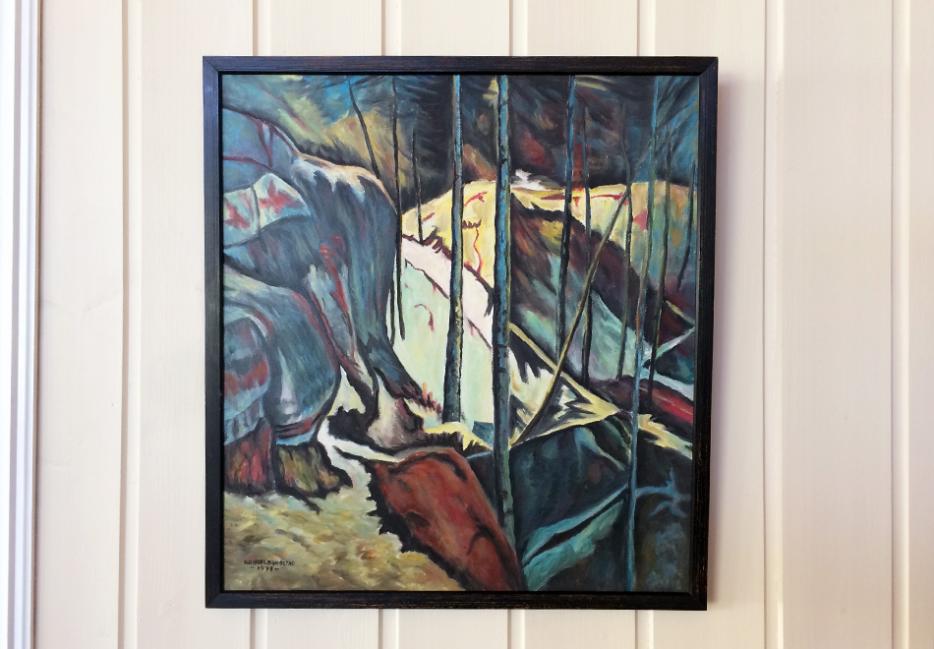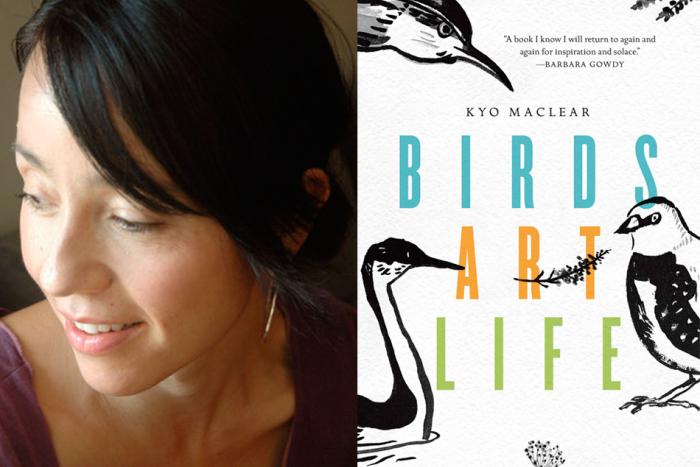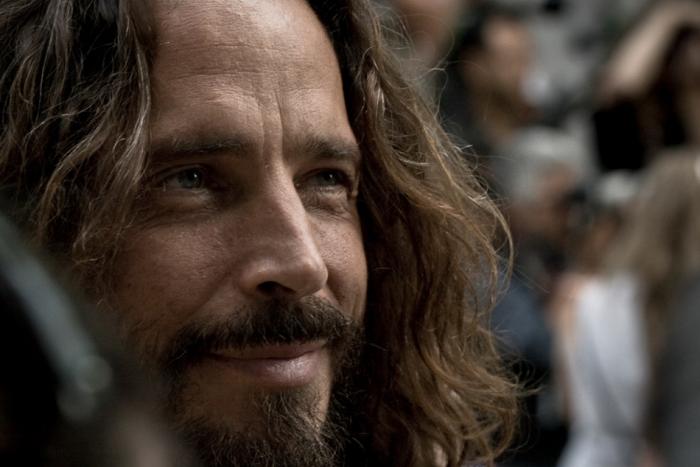There was a painting hanging in the house where I grew up—Troll Forest, my mother called it. As a child I found the scene scary: it’s a moody forest, the kind where the sunlight doesn’t reach all the way to the ground. Among the rocks and trees there’s a stone structure that resembles a troll, one of those large, ugly creatures described in Nordic folklore.
To a connoisseur, it’s probably not a very good piece of art. I like the colours, though: shades of rust red, steel blue, muddy yellow. Having looked at that picture for over 30 years, my feelings have moved from fear, to indifference, to affection. It looks a bit amaterur-ish but I like it a lot—it’s always been part of my life. I like looking at Troll Forest for the same reasons I like looking at the face of a person I’ve known forever.
There’s a signature in the corner of the painting, in neat block letters: Samuel Slyngstad, 1978. Over at my grandma’s house, Samuel’s signature can be found on three more canvases. A couple of my uncles have Samuels too, and my father’s cousin even has her own version of Troll Forest. Samuels everywhere! Clearly this Samuel Slyngstad was an artist of some repute.
It was a long time before I realised that Samuel wasn’t actually a famous painter. I first started looking into Samuel some ten years ago out of idle curiosity, only to find that no one had heard of him. There’s nothing on the Internet. But in my family, everyone knows his name. How did Samuel Slyngstad, obscure painter, became so famous to us?
I asked my mother about Samuel the last time I visited. But she knew nothing about him, except that his painting came to us through family. “Your dad’s mother, it was her brother, let me think. The woman he was married to, I think Samuel was her father.” Not much, but it was a start.
Samuel Slyngstad was remarkably ordinary, I came to learn: he lived his whole life in Ålesund where he was born, a manual labourer whose hobby was painting. Every single one of Samuel’s paintings are copies, imitations of works by fine artists. Does that mean there’s an original Troll Forest out there?
*
My father met Samuel several times as a child, he tells me when I call to ask about our old painting. “Every summer we’d travel down to mum’s parents at Sunnmøre, and most years we’d stop to visit Uncle Arthur and Aunt Bjørg. Her father Samuel lived upstairs,” he says. This was at Ragnvald Jarls Street in downtown Ålesund, a mid-size coastal town in Western Norway. “Their house was full of his paintings,” says my father, suggesting I contact his cousin Yngve, Samuel’s grandson.
I find Yngve Eiken on Facebook where he responds almost immediately, more than happy to talk about his grandfather’s paintings. “I never thought of Grandpa as an artist anyone would know about,” Yngve tells me in his singsong Ålesund accent. “He never wanted to hear anything of it!” He laughs. “They wanted him to join them at the city art collective, but Grandpa refused, telling them he had no business being there. I suppose he didn’t really think he was good enough. He didn’t want to be called an artist.”
While Samuel may have refused to call himself an artist, people enjoyed his work, and they wanted to buy it. So when friends, family and the occasional tourist came knocking, Samuel had to find a way to reconcile this demand with his non-artist self image: “He asked for payment to cover the canvas and the paint, nothing more.”
Yngve spent a lot of time with his grandfather as a boy, making things and going on trips to the woods. When Yngve and his parents eventually moved away from the house they shared with grandpa, Samuel would visit every day. “He was a man of routine. No matter the weather, every day he’d come at 4 p.m., or if it was a Sunday, at 11 a.m. He’d sit for an hour before going home, always on foot.”
Samuel’s most productive years came towards the end of his life—he was a widower for two decades. “Four of the eleven Slyngstad siblings were painters, but none of them could afford to go to art school,” says Yngve. Samuel would find pictures of famous paintings in books, or in newspapers left down on the docks, and tear out pages to take home. There he’d sketch the image onto a larger canvas and add colour—often from imagination if the inspiration was black and white.
When I describe my parents’ picture, Troll Forest, Yngve knows the one I’m talking about even before I’ve sent him a photo. “That’s Troll Rockslide,” he declares confidently. He has one just like it, and his sister has one too. He laughs. “So there are four or five of these ones, huh? I had no idea.”
*
The art of copying fine art has a long history; the likes of Monet, Picasso and Van Gogh learned the craft by copying the old masters. And since most people can’t afford the originals, there’s always been a market for buying copies. Today, industrial-scale art copyist operations are plentiful in China, so if you want a knock-off Matisse you can get one in just a few clicks. But if you want a copy that can fool an art connoisseur, you need to hire a specialist.
Susie Ray, an art copyist living in Cornwall, England, says it takes much longer to copy a painting than to create an original. Her bread and butter is painting for people who’re looking for exact replicas of famous works. People seek her out because they have the original in a vault but want one for the wall, or because they don’t have the real deal but want people to think they do—Ray is very discreet.
Ray will only replicate a painting once: “I put in a huge amount of energy. It’s recreating someone else’s work, and [it takes a vast] amount of time and concentration.” The process is a lot like solving a puzzle, says Ray, explaining how she needs to use the same type of canvas, paint and brushes as the original, and replicate the way it dried so the textures build up in the same way. “You have to approach the painting the same way the artist did. Because you are copying, you’re painting a lot slower, so you have to [try to] keep the same spontaneity of the original painting.”
Ray always signs the backs of her copies, as she has no desire to pass off her works as originals. “People often talk about how the original painting has an aura to it,” she says when I ask how she views her copies in relation to the originals. “But if you take a good copy and put it on the wall and no one knows, it still has that aura.” Ray laughs. “I don’t make it too complicated, though. I just make the copy.”
*
Just how important is authenticity? I know the Samuel painting I grew up with isn’t one-of-a-kind, so whatever value it has will always be about something else. But authenticity remains something we covet. I thought about this recently when I visited the Picasso Museum in Barcelona, wandering around in silent awe among the thousands of originals, many of which I’d previously only seen in reproduction. To stand in front of a Picasso is to be in the presence of true genius, watching as mastery meets mad creativity. Maybe if they’d all been copies it wouldn't have made a difference to my experience—except that if I’d known, I’d never have bothered going.
We look for authenticity everywhere. Travellers look for so-called genuine local experiences away from the crowds; we seek out true versions of dishes; we buy director’s cuts of films and unabridged books. Even those who prefer a no-stress pool vacation and the mildest curry on the menu may well cop to a desire for a degree of authenticity in their interactions, as I learned when a then-boyfriend discovered I’d been texting the same holiday photos to a friend as I did to him. We want our experiences to be meaningful, and this often translates to a desire for originality. But does this mean they need to be unique to have value?
“I love the process of seeing a painting emerge. It's an original experience,” says Antonia Williams, an art copyist who also makes her own art. Speaking via Skype from her home in Portugal, Williams laments the quality of copies from industrial-scale operations in China, where the painters have never seen the original, let alone researched the methods. “There’s an awful lot of bad copying around, by people who don’t understand the method of slowly building up a painting.” A bad copyist may simply start in one corner and move across the canvas, says Williams, instead of building up the layers to replicate the process of the original artist.
Williams’s favourite artist to copy is Chardin, the 18th-century French painter. And it’s when she describes the process of copying Chardin that I finally understand why someone might choose to dedicate themselves to the art of copying: “It's very subtle. The colour is very subtle. When you start painting, you understand how complex his paintings are. When you look at it you think, ‘Oh that's lovely.’ But when you start copying, you realise his vision was very specific, what he was searching for. When I'm copying the painting, I'm also experiencing his search.”
Samuel was a family man who built roads and bridges for a living, stone by stone in the streets of Ålesund. For him, being an artist seemed impossible. At first I didn’t understand why he wouldn’t create original works, but after speaking to the art copyists I think I see what he was doing: copying works of famous artists let him experience a world otherwise out of reach.
*
Troll Forest currently sits in a closet in my mother’s house, relegated there from the living room, by way of a few years in the hallway. My plan is to save our Samuel from obscurity and hang him on the wall of my home in London. I know it’s a copy—it’s not even a one-of-a-kind copy—but still, it’s valuable to me.
I can just about picture Samuel, flicking through newspapers left around the docks of Ålesund, finding Troll Forest in one of them and deciding to give it a go. I’d come to accept that the inspiration for Troll Forest was some random, obscure picture I’d never find, but after speaking to Yngve I decided to take one last crack at it. Armed with the proper title—Troll Rockslide—it’s almost rudely easy. My jaw literally dropped as my laptop screen filled with the original that Samuel must have copied, like a magician flicking back the curtain to reveal the trick behind the illusion. The style is different but this is definitely it: “Trollura i Jahrskogen”—Troll Rockslide in Jahr Forest. Painted in 1933 by Henrik Sørensen, a Norwegian artist who’d studied under Matisse, the canvas resides at Holmsbu Gallery in Hurum, an hour’s drive south of Oslo. In fact, the entire gallery is situated within the very same moody old forest that the painting depicts.
Henrik Sørensen was a passionate advocate for preserving the virgin forest, presumably the reason why he chose it as the theme of Troll Rockslide. Samuel Slyngstad would have created his copy in his studio in Ålesund, steadfastly refusing the label of artist as he channeled the experience of being one. My copy of Troll Rockslide was a gift to my parents from family, shortly after they’d moved into their first home and had all those bare walls to fill. “He was a bit folksy, Samuel. It was art for the everyman.” That’s my father’s take on the appeal of Samuel’s work. Just like the art of copying is a window into someone else’s experience, owning a copy lets you peek into a world that you otherwise may have no access to.
My unoriginal and inaccurate copy of Troll Rockslide is miles from being authentic, but now more than ever I feel like it’s part of a bigger story—it’s had a secret life for all these years. My painting is the story of an artist striving to save a precious forest, a dock worker dreaming of a creative life, a young family starting out in a country village—and now, a daughter who’s crossed borders to live in a global metropolis. I don’t need a copy to be in the presence of art—London has dozens of museums full of famous originals and I can go and experience them whenever I want. But that’s not what my Samuel Slyngstad canvas is about. My beloved fake is a reminder to me that everyone wants something, and it’s good to dream a little.






